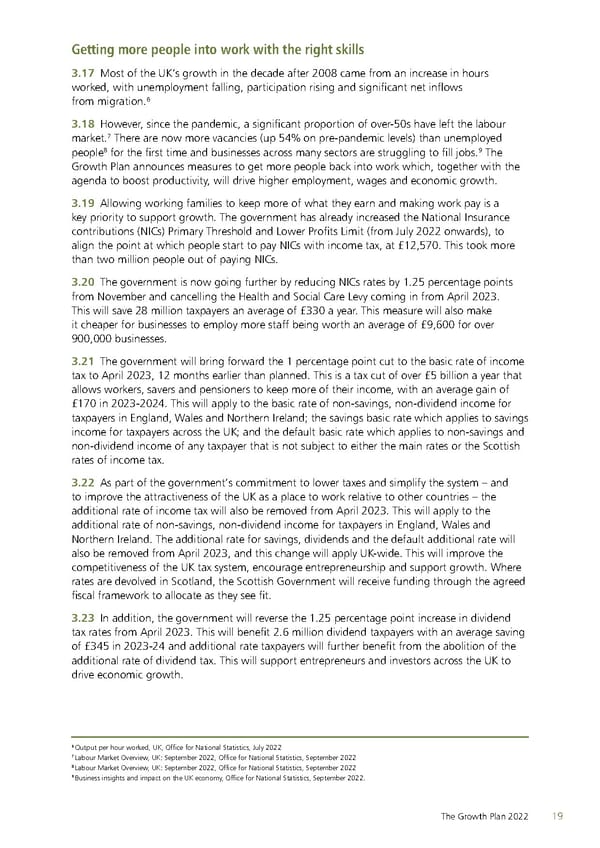Getting more people into work with the right skills 3.17 Most of the UK’s growth in the decade after 2008 came from an increase in hours worked, with unemployment falling, participation rising and significant net inflows 6 from migration. 3.18 However, since the pandemic, a significant proportion of over-50s have left the labour 7 market. There are now more vacancies (up 54% on pre-pandemic levels) than unemployed 8 9 people for the first time and businesses across many sectors are struggling to fill jobs. The Growth Plan announces measures to get more people back into work which, together with the agenda to boost productivity, will drive higher employment, wages and economic growth. 3.19 Allowing working families to keep more of what they earn and making work pay is a key priority to support growth. The government has already increased the National Insurance contributions (NICs) Primary Threshold and Lower Profits Limit (from July 2022 onwards), to align the point at which people start to pay NICs with income tax, at £12,570. This took more than two million people out of paying NICs. 3.20 The government is now going further by reducing NICs rates by 1.25 percentage points from November and cancelling the Health and Social Care Levy coming in from April 2023. This will save 28 million taxpayers an average of £330 a year. This measure will also make it cheaper for businesses to employ more staff being worth an average of £9,600 for over 900,000 businesses. 3.21 The government will bring forward the 1 percentage point cut to the basic rate of income tax to April 2023, 12 months earlier than planned. This is a tax cut of over £5 billion a year that allows workers, savers and pensioners to keep more of their income, with an average gain of £170 in 2023-2024. This will apply to the basic rate of non-savings, non-dividend income for taxpayers in England, Wales and Northern Ireland; the savings basic rate which applies to savings income for taxpayers across the UK; and the default basic rate which applies to non-savings and non-dividend income of any taxpayer that is not subject to either the main rates or the Scottish rates of income tax. 3.22 As part of the government’s commitment to lower taxes and simplify the system – and to improve the attractiveness of the UK as a place to work relative to other countries – the additional rate of income tax will also be removed from April 2023. This will apply to the additional rate of non-savings, non-dividend income for taxpayers in England, Wales and Northern Ireland. The additional rate for savings, dividends and the default additional rate will also be removed from April 2023, and this change will apply UK-wide. This will improve the competitiveness of the UK tax system, encourage entrepreneurship and support growth. Where rates are devolved in Scotland, the Scottish Government will receive funding through the agreed fiscal framework to allocate as they see fit. 3.23 In addition, the government will reverse the 1.25 percentage point increase in dividend tax rates from April 2023. This will benefit 2.6 million dividend taxpayers with an average saving of £345 in 2023-24 and additional rate taxpayers will further benefit from the abolition of the additional rate of dividend tax. This will support entrepreneurs and investors across the UK to drive economic growth. 6 Output per hour worked, UK, Office for National Statistics, July 2022 7 Labour Market Overview, UK: September 2022, Office for National Statistics, September 2022 8 Labour Market Overview, UK: September 2022, Office for National Statistics, September 2022 9 Business insights and impact on the UK economy, Office for National Statistics, September 2022. The Growth Plan 2022 19
 The Growth Plan 2022 Page 19 Page 21
The Growth Plan 2022 Page 19 Page 21